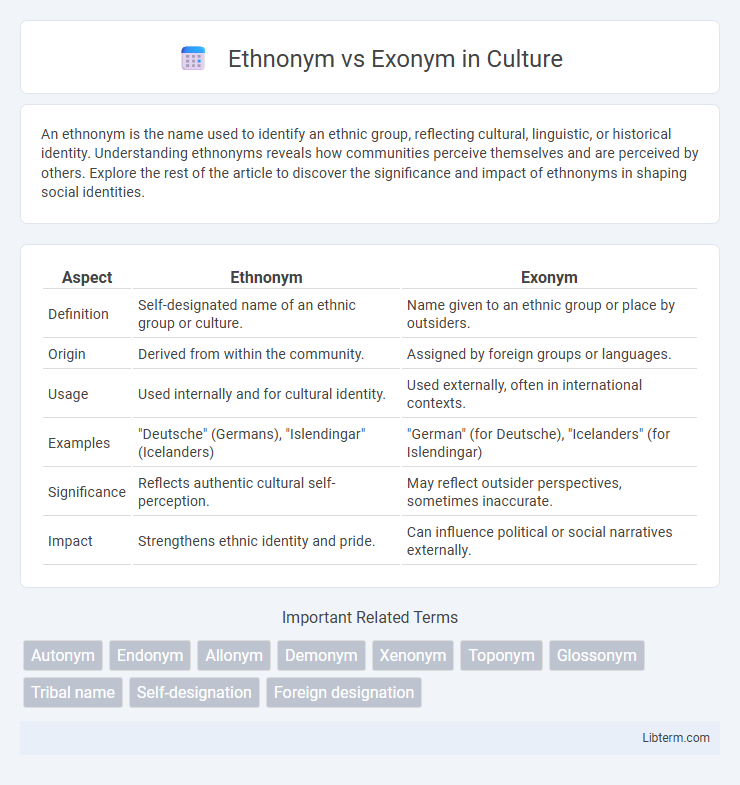An ethnonym is the name used to identify an ethnic group, reflecting cultural, linguistic, or historical identity. Understanding ethnonyms reveals how communities perceive themselves and are perceived by others. Explore the rest of the article to discover the significance and impact of ethnonyms in shaping social identities.
Table of Comparison
| Aspect | Ethnonym | Exonym |
|---|---|---|
| Definition | Self-designated name of an ethnic group or culture. | Name given to an ethnic group or place by outsiders. |
| Origin | Derived from within the community. | Assigned by foreign groups or languages. |
| Usage | Used internally and for cultural identity. | Used externally, often in international contexts. |
| Examples | "Deutsche" (Germans), "Islendingar" (Icelanders) | "German" (for Deutsche), "Icelanders" (for Islendingar) |
| Significance | Reflects authentic cultural self-perception. | May reflect outsider perspectives, sometimes inaccurate. |
| Impact | Strengthens ethnic identity and pride. | Can influence political or social narratives externally. |
Understanding Ethnonyms and Exonyms
Ethnonyms are the names that a particular ethnic group uses to identify itself, reflecting internal cultural identity and self-perception. Exonyms, in contrast, are names given to a group by outsiders, often derived from historical, linguistic, or colonial contexts that may not align with the group's own designation. Understanding ethnonyms and exonyms is crucial for accurate cultural representation, respectful communication, and the study of ethnolinguistics and anthropology.
Definitions: What Are Ethnonyms and Exonyms?
Ethnonyms refer to the names that a group of people use to identify themselves within their own language and culture, often reflecting their unique identity and heritage. Exonyms are the names given to a group or place by outsiders, which may differ significantly from the group's self-designation and can reveal external perspectives or historical influences. Understanding the distinction between ethnonyms and exonyms is crucial in fields like linguistics, anthropology, and geography for accurate representation of cultural identities.
Origins and Etymology of Ethnonyms
Ethnonyms originate from the native language of a particular group and often carry meanings related to identity, culture, or geographic origin, reflecting how communities self-identify. Their etymology reveals connections between language evolution, historical migration, and social structures within ethnic groups. Understanding ethnonyms requires analyzing linguistic roots and the socio-cultural context embedded in the names a group uses for itself.
How Exonyms Develop and Spread
Exonyms develop and spread through historical interactions such as trade, colonization, and cultural exchange, where one group assigns a name to another group or place different from the self-designated ethnonym. Geographic barriers, language differences, and limited direct contact often result in the adoption of exonyms by external groups, sometimes preserving outdated or altered forms of the original names. The diffusion of exonyms is facilitated by maps, literature, and diplomatic communications, embedding these external names into global discourse and official records.
Examples of Ethnonyms Across Cultures
Ethnonyms represent the names that groups use to identify themselves, such as "Inuit" for indigenous Arctic peoples or "Sami" for the indigenous people of Northern Europe, reflecting cultural identity and self-perception. Exonyms contrast as names given by outsiders, like "Eskimo" or "Lapps," which can carry different connotations or historical biases. Understanding ethnonyms is crucial in anthropology and linguistics as they offer insight into a group's heritage, cultural pride, and linguistic distinctiveness.
Notable Exonyms in World History
Notable exonyms such as "Germany" for "Deutschland" and "Japan" for "Nippon" demonstrate how external naming shapes international perceptions and cultural identity. These exonyms often arise from historical trade routes, colonial influence, or linguistic adaptations, reflecting geopolitical power dynamics. Understanding exonyms reveals the complex interactions between self-identification (ethnonyms) and external labeling in global history.
Cultural Significance of Ethnonyms
Ethnonyms hold profound cultural significance as they represent the self-identified names of ethnic groups, embodying their heritage, identity, and collective memory. Unlike exonyms, which are external labels often imposed by outsiders, ethnonyms reflect the internal perspective and linguistic traditions of a community. Recognizing and respecting ethnonyms fosters cultural preservation, promotes social cohesion, and combats the erasure or misrepresentation of indigenous identities in global discourse.
The Politics of Naming: Exonyms vs. Ethnonyms
Ethnonyms represent the self-designated names of ethnic groups or communities, reflecting their own cultural identity and heritage. Exonyms, by contrast, are names given by outsiders, often influenced by historical conquests, colonialism, or political agendas, which can lead to misrepresentation or erasure of the group's identity. The politics of naming encapsulates the struggle for cultural recognition and respect, where reclaiming ethnonyms challenges the dominance of exonyms and promotes indigenous sovereignty and authenticity.
Impacts of Using Exonyms in Modern Discourse
Using exonyms in modern discourse can perpetuate cultural misunderstandings and reinforce external perspectives that may not respect the identity or language of the named group. This practice often leads to inaccuracies in geographical, ethnic, or cultural representation, affecting diplomatic relations and social integration efforts. Emphasizing endonyms supports cultural autonomy and promotes inclusivity by honoring self-identification and local language conventions.
Towards Respectful Naming Practices
Ethnonyms, the names groups use to identify themselves, reflect cultural identity and self-perception, while exonyms are externally assigned names that may carry historical inaccuracies or biases. Respectful naming practices prioritize the use of ethnonyms to honor the autonomy and heritage of communities, fostering accuracy and sensitivity in representation. Embracing ethnonyms in official documents, maps, and discourse reduces cultural misappropriation and supports social inclusion.
Ethnonym Infographic

 libterm.com
libterm.com